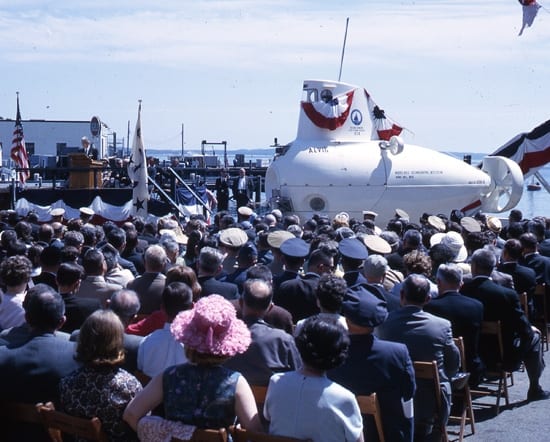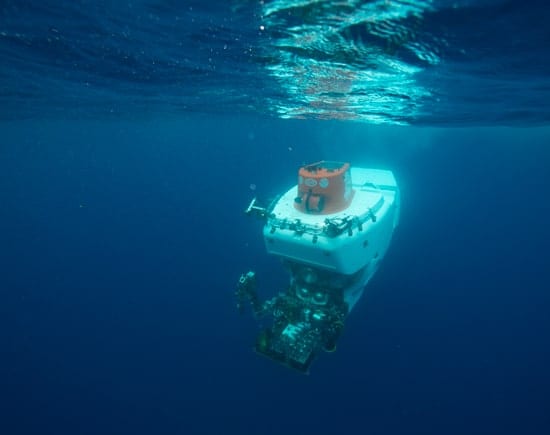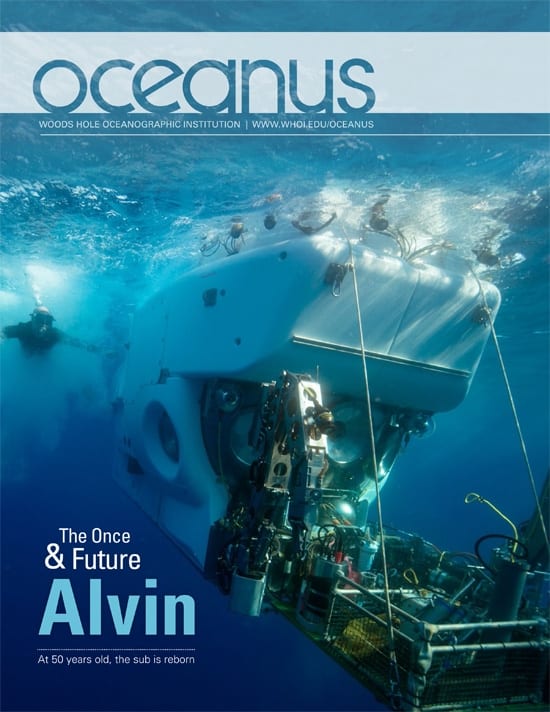Iconic Research Submersible Alvin Turns 50
June 5, 2014
We know more about the surface of other planets than we do about Earth’s ocean. And what is known about our ocean would not have been possible without the deep-sea submersible Alvin, one of the hardest working, most reliable vehicles for oceanography.
Alvin, the iconic research submersible owned by the U.S. Navy and operated by Woods Hole Oceanographic Institution (WHOI), turns 50 this year. Christened on June 5, 1964, the sub has been a workhorse for U.S. scientists, safely taking approximately 2,600 researchers on nearly 4,900 dives, and enabling countless scientific discoveries.
“As the U.S.’s only deep-diving research submersible, Alvin is a national asset,” said WHOI President and Director Susan Avery. “Alvin has not only enabled the routine exploration of the ocean and helped discover hundreds of previously unknown species, but it has also ignited a passion for science and marine life in people of every generation.”
To mark the anniversary, WHOI is asking people to send birthday messages to Alvin which will be posted on a new Alvin 50th anniversary website and Facebook page for everyone to see. The website also contains milestones in Alvin’s history, videos of Alvin through the years, activities for kids, and a virtual tour of the sub.
The Institution has also produced a special Alvin commemorative issue of Oceanus magazine, containing articles and photos that detail Alvin‘s illustrious history, curious facts, and operations. It also tells the story of the most extensive upgrade in the sub’s history, including interviews with more than three dozen engineers, pilots, technicians, and scientists who describe, in their own words, the roles they played in designing and building the new Alvin.
Alvin’s legacy
Alvin proved its value to the nation soon after it was built, when in 1966 the U.S. Navy brought it to Spain to locate and recover a hydrogen bomb lost in the Mediterranean Sea. After a two-month search, Alvin succeeded in finding the bomb and proving its ability to perform at the seafloor.
Alvin‘s lasting value, however, has been its ability to enable a human presence in the deep ocean, a novel idea when the sub was first conceived in 1956 by its namesake, WHOI geophysicist Allyn Vine.
“The value of Alvin is unarguable,” said Alvin Expedition Leader Bruce Strickrott. “It has helped make individual science careers, and for those who have had a chance to dive in it, it’s life changing.”
In the early 1970s, Alvin brought scientists for the first time to the mid-ocean ridge – the 40,000-mile-long mountain chain that circles the Earth. In 1977, scientists inside Alvin first explored the lush communities of life thriving without sunlight at seafloor hydrothermal vents— one of the most profound scientific discoveries of the 20th century.
“Alvin has been, and continues to be, invaluable in conducting my research around hydrothermal vents,” said Susan Humphris, a WHOI geologist who has had approximately 30 dives in Alvin, “and I have been able to bring the wonder of exploring the seafloor to students and the general public.”
Following work in 2010 investigating the impacts of the Deepwater Horizon oil spill on deep-sea coral communities in the Gulf of Mexico, Alvin received the most extensive upgrade in its history—funded largely by the National Science Foundation. It returned to service in 2014 with enhanced components and capabilities: a new, larger personnel sphere with improved interior ergonomics; five viewports (instead of the previous three) to improve visibility and provide overlapping fields of view; new lighting and high-definition imaging systems; new syntactic foam providing buoyancy; and an improved command-and-control system.
“Alvin is a unique and important resource,” said Adam Soule, a geologist and the newly-appointed scientific lead with the National Deep Submergence Facility at WHOI. “As chief scientist for deep submergence, I am passionate about enabling direct observations and sampling in the deep ocean by scientists across disciplines from genetics to geology, as I have experienced first-hand the remarkable insights that can be achieved by the small team of pilot and observers conducting science on the seafloor.”
“For fifty years, Alvin has been at the forefront of ocean exploration,” said Avery. “With its recent upgrade, Alvin will continue to help expand our knowledge of the planet and inspire new generations of scientists, engineers, and explorers for decades to come.”
The Woods Hole Oceanographic Institution is a private, non-profit organization on Cape Cod, Mass., dedicated to marine research, engineering, and higher education. Established in 1930 on a recommendation from the National Academy of Sciences, its primary mission is to understand the ocean and its interaction with the Earth as a whole, and to communicate a basic understanding of the ocean’s role in the changing global environment. For more information, please visit www.whoi.edu.



